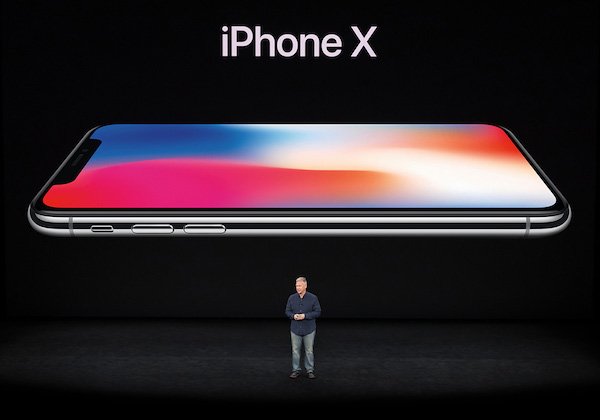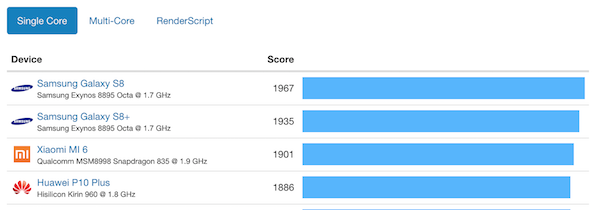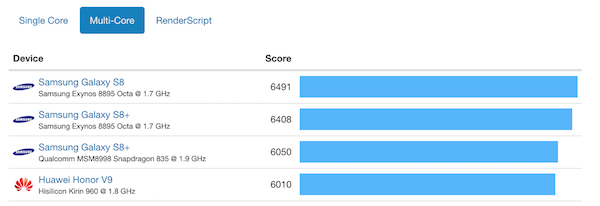Competitors had been finding it difficult to beat the A10 Fusion processor in performance. Apple went ahead and beat it themselves by launching a new A11 Bionic SoC which powers iPhone 8 and iPhone X. The processor is a beast and current benchmarks show that it not only destroys the competition, it also beats Intel’s Core i5 processor in some benchmarks.

From Geekbench, here are the single core benchmarks for A11 Bionic:

These are the single core benchmarks by various processors (Exynos, Qualcomm, Kirin) being used in competing Android phones.

These are the multi-core benchmarks. A11 Bionic:

Processors used in Android devices:

As you can see, A11 Bionic destroys the competition in every way possible. All this, while providing even better energy efficiency than previous processors.
http://twitter.com/MKBHD/status/912277929027100672
A11 has 6 cores, with 2 high performance cores and 4 low performance cores. The SoC uses a second-generation performance controller, also built in-house by Apple, which has a major benefit over the previous generation A10 Fusion SoC – it lets the A11 use all 6 cores simultaneously. A11’s high performance cores achieve 25% faster performance than A10, while its low performance cores are 70% faster than A10’s.
Along with the CPU cores, A11 also has a custom-made 3-core GPU with 30% faster performance than A10’s. A11 also has a ‘neural engine‘ which is a dedicated chip for tasks which require machine learning. This neural engine can perform 600 billion operations per second. It also powers the new FaceID in iPhone X. An M11 motion coprocessor and a DSP for rich audio quality round up the package.
Does this mean that Apple will replace the Intel processors in Macs with their own ARM processors? Not anytime soon. While the A-series SoC is great at energy efficiency and quick burst tasks, there is still some time before it can go head-to-head with Intel chipsets for sustained performance over long periods. Whether it is capable of doing that right now is almost impossible to guess for anybody outside of Apple, as these processors are exclusive to iOS hardware. Apart from some Geekbench scores, there are not a lot of ways to run comparisons between Apple’s ARM and Intel’s x86 processors.
TL;DR: A11 Bionic details
- 10nm size
- 64-bit architecture
- Image processor (to handle computational photography)
- M11 (motion coprocessor)
- GPU (for graphics)
- Neural Engine (for artificial intelligence related tasks)
- Digital Signal Processor (responsible for audio quality)
- As fast as a 7th generation Intel Core i5 processor found in MacBook Pro
Note: Qualcomm and Samsung still need to catch up with A10 Fusion.
Here is little background for those who are not aware of Apple’s history with designing processors. Before Apple moved to Intel processors for Macs, the company used PowerPC processors which it developed in collaboration with IBM and Motorola. While PowerPC did not end well due to various reasons, Apple was also involved with ARM since the 1980s. Apple was one of the first companies to create a portable computing device with an ARM processor, called Newton, which was so ahead of its time that it failed. This is a short summary of Apple’s history of designing and creating processors but none of those efforts come close to what they have achieved with the A series of chips. They have created chips that can help record 4K video at 60fps on a smartphone, which not even many DSLRs can do.
Make sure to read Mashable’s interview with Phil Schiller, Apple Senior Vice President of Worldwide Marketing and Johny Srouji, SVP of Hardware Technologies, for an insight of what goes on behind the scenes of Apple’s SoC planning and development.
1 comment
Comments are closed.